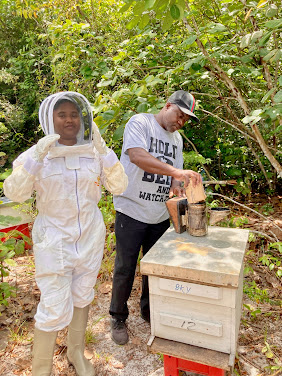Survey of Jamaican Beekeepers Reveals Significant Improvement in Beekeeping Knowledge and Capacity
Tom Hebert, Returned Peace Corps Volunteer, beekeeper and English teacher who resides in Intibucá, Honduras, spent the month of July working with beekeeping associations in 6 of Jamaica’s 14 parishes. This was Tom’s second visit to Jamaica – following his first Farmer to Farmer (F2F) assignment in July 2012 – and the 8th F2F assignment focused on low-cost, sustainable beekeeping in Jamaica in the last year.
Tom’s 11 hands-on training sessions focused on building top-bar hives, hive management, and making home-made pollen traps and foundation molds – skills identified by the associations as areas where they needed to increase their capacity. Of the 72 recorded participants, 66.6% had attended a previous F2F beekeeping training, and just over 25% were present at Tom’s first session in 2012.
Two summer interns at Yerba Buena Farm in St. Mary parrish accompanied Tom to his trainings and conducted a survey of the 72 participants to gain a better understanding of why they were interested in beekeeping, the current state of their individual beekeeping practices, and the impact of F2F volunteer assistance over the past year. The following graphs illustrate the results of the survey, which revealed that a majority of participants are interested in beekeeping as a primary or supplementary income source, and, through attending F2F trainings, participants have significantly increased their beekeeping knowledge and capacity.
Tom’s 11 hands-on training sessions focused on building top-bar hives, hive management, and making home-made pollen traps and foundation molds – skills identified by the associations as areas where they needed to increase their capacity. Of the 72 recorded participants, 66.6% had attended a previous F2F beekeeping training, and just over 25% were present at Tom’s first session in 2012.
Two summer interns at Yerba Buena Farm in St. Mary parrish accompanied Tom to his trainings and conducted a survey of the 72 participants to gain a better understanding of why they were interested in beekeeping, the current state of their individual beekeeping practices, and the impact of F2F volunteer assistance over the past year. The following graphs illustrate the results of the survey, which revealed that a majority of participants are interested in beekeeping as a primary or supplementary income source, and, through attending F2F trainings, participants have significantly increased their beekeeping knowledge and capacity.






.png)

Comments
Post a Comment